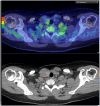Rare duplication of the CDC73 gene and atypical hyperparathyroidism-jaw tumor syndrome: A case report and review of the literature
- PMID: 36639964
- PMCID: PMC10178793
- DOI: 10.1002/mgg3.2133
Rare duplication of the CDC73 gene and atypical hyperparathyroidism-jaw tumor syndrome: A case report and review of the literature
Abstract
Background: Hyperparathyroidism jaw-tumor syndrome (HPT-JT) is the rarest familial cause of primary hyperparathyroidism, with an incidence <1/1000000, caused by a pathogenic variant in the CDC73 (or HRPT2) gene that encodes parafibromin, a protein involved in many cellular mechanisms. Patients with HPT-JT have a 15-20% of risk of developing parathyroid carcinoma, whereas it accounts for only 1% of all cases of primary hyperparathyroidism. Patients also develop jaw tumors in 30% of cases, kidney abnormalities in 15% of cases, and uterine tumors in 50% of patients.
Case report: Here are report two atypical cases of HPT-JT with variable expressivity in the same family. In front of an isolated primary hyperparathyroidism at 28 years of age of incidental discovery following a weight gain, the propositus benefited a first-line panel by Next-Generation Sequencing of the genes involved in familial hyperparathyroidism: CaSR, CDC73, MEN1, and RET. Genetic testing revealed the presence of a pathogenic germline variation CDC73: c.687_688dup; p.Val230Glufs*28, found only in nine families in the literature and allowing the diagnosis of HPT-JT. Given a history of primary hyperparathyroidism at 52 years and adenomyosis, the patient's mother also underwent a genetic analysis that found her daughter's variation and established her inherited trait.
Conclusion: In view of the clinical and genotypic heterogeneity, we confirm the interest of using an extended gene panel for the diagnosis of familial primary hyperparathyroidism. CDC73 variations could be more frequent than described in the literature. The association of primary hyperparathyroidism with uterine involvement could be a new indication for analysis.
Keywords: CDC73; HPT-JT syndrome; adenomyosis; rare duplication.
© 2023 The Authors. Molecular Genetics & Genomic Medicine published by Wiley Periodicals LLC.
Conflict of interest statement
The authors declare no conflict of interest.
Figures



References
-
- Arnold, A. , & Marx, S. J. (2013). Familial primary hyperparathyroidism (including MEN, FHH, and HPT‐JT). In Rosen C. J. (Ed.), Primer on the metabolic bone diseases and disorders of mineral metabolism (pp. 553–561). John Wiley & Sons, Ltd. 10.1002/9781118453926.ch69 - DOI
-
- Bradley, K. J. , Hobbs, M. R. , Buley, I. D. , Carpten, J. D. , Cavaco, B. M. , Fares, J. E. , Laidler, P. , Manek, S. , Robbins, C. M. , Salti, I. S. , Thompson, N. W. , Jackson, C. E. , & Thakker, R. V. (2005). Uterine tumours are a phenotypic manifestation of the hyperparathyroidism‐jaw tumour syndrome. Journal of Internal Medicine, 257(1), 18–26. 10.1111/j.1365-2796.2004.01421.x - DOI - PubMed
-
- Bricaire, L. , Odou, M. F. , Cardot‐Bauters, C. , Delemer, B. , North, M. O. , Salenave, S. , Vezzosi, D. , Kuhn, J. M. , Murat, A. , Caron, P. , Sadoul, J. L. , Silve, C. , Chanson, P. , Barlier, A. , Clauser, E. , Porchet, N. , Groussin, L. , & the GTE Group . (2013). Frequent large germline HRPT2 deletions in a French National Cohort of patients with primary hyperparathyroidism. The Journal of Clinical Endocrinology & Metabolism, 98(2), E403–E408. 10.1210/jc.2012-2789 - DOI - PubMed
-
- Carpten, J. D. , Robbins, C. M. , Villablanca, A. , Forsberg, L. , Presciuttini, S. , Bailey‐Wilson, J. , Simonds, W. F. , Gillanders, E. M. , Kennedy, A. M. , Chen, J. D. , Agarwal, S. K. , Sood, R. , Jones, M. P. , Moses, T. Y. , Haven, C. , Petillo, D. , Leotlela, P. D. , Harding, B. , Cameron, D. , … Hobbs, M. R. (2002). HRPT2, encoding parafibromin, is mutated in hyperparathyroidism–jaw tumor syndrome. Nature Genetics, 32(4), 676–680. 10.1038/ng1048 - DOI - PubMed
Publication types
MeSH terms
Substances
Supplementary concepts
LinkOut - more resources
Full Text Sources

